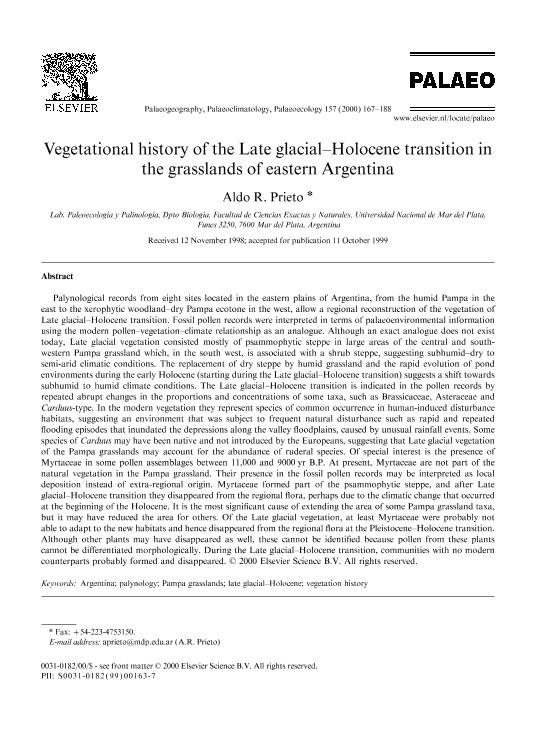Artículo
Vegetational history of the Late glacial - Holocene transition in the grasslands of eastern Argentina
Fecha de publicación:
04/2000
Editorial:
Elsevier Science
Revista:
Palaeogeography, Palaeoclimatology, Palaeoecology
ISSN:
0031-0182
Idioma:
Inglés
Tipo de recurso:
Artículo publicado
Clasificación temática:
Resumen
Palynological records from eight sites located in the eastern plains of Argentina, from the humid Pampa in the east to the xerophytic woodland–dry Pampa ecotone in the west, allow a regional reconstruction of the vegetation of Late glacial–Holocene transition. Fossil pollen records were interpreted in terms of palaeoenvironmental information using the modern pollen–vegetation–climate relationship as an analogue. Although an exact analogue does not exist today, Late glacial vegetation consisted mostly of psammophytic steppe in large areas of the central and south-western Pampa grassland which, in the south west, is associated with a shrub steppe, suggesting subhumid–dry to semi-arid climatic conditions. The replacement of dry steppe by humid grassland and the rapid evolution of pond environments during the early Holocene (starting during the Late glacial–Holocene transition) suggests a shift towards subhumid to humid climate conditions. The Late glacial–Holocene transition is indicated in the pollen records by repeated abrupt changes in the proportions and concentrations of some taxa, such as Brassicaceae, Asteraceae and Carduus-type. In the modern vegetation they represent species of common occurrence in human-induced disturbance habitats, suggesting an environment that was subject to frequent natural disturbance such as rapid and repeated flooding episodes that inundated the depressions along the valley floodplains, caused by unusual rainfall events. Some species of Carduus may have been native and not introduced by the Europeans, suggesting that Late glacial vegetation of the Pampa grasslands may account for the abundance of ruderal species. Of special interest is the presence of Myrtaceae in some pollen assemblages between 11,000 and 9000 yr B.P. At present, Myrtaceae are not part of the natural vegetation in the Pampa grassland. Their presence in the fossil pollen records may be interpreted as local deposition instead of extra-regional origin. Myrtaceae formed part of the psammophytic steppe, and after Late glacial–Holocene transition they disappeared from the regional flora, perhaps due to the climatic change that occurred at the beginning of the Holocene. It is the most significant cause of extending the area of some Pampa grassland taxa, but it may have reduced the area for others. Of the Late glacial vegetation, at least Myrtaceae were probably not able to adapt to the new habitats and hence disappeared from the regional flora at the Pleistocene–Holocene transition. Although other plants may have disappeared as well, these cannot be identified because pollen from these plants cannot be differentiated morphologically. During the Late glacial–Holocene transition, communities with no modern counterparts probably formed and disappeared.
Archivos asociados
Licencia
Identificadores
Colecciones
Articulos(IIMYC)
Articulos de INSTITUTO DE INVESTIGACIONES MARINAS Y COSTERAS
Articulos de INSTITUTO DE INVESTIGACIONES MARINAS Y COSTERAS
Citación
Prieto, Aldo Raul; Vegetational history of the Late glacial - Holocene transition in the grasslands of eastern Argentina; Elsevier Science; Palaeogeography, Palaeoclimatology, Palaeoecology; 157; 3-4; 4-2000; 167-188
Compartir
Altmétricas




